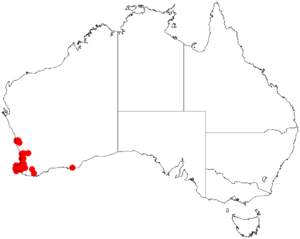Acacia obovata facts for kids
Quick facts for kids Acacia obovata |
|
|---|---|
| Scientific classification | |
| Genus: |
Acacia
|
| Species: |
obovata
|
 |
|
| Occurrence data from AVH | |
Acacia obovata is a type of shrub, a bushy plant, that belongs to the large Acacia family. It is special because it only grows in the southwestern part of Australia. This means it is an endemic plant, found nowhere else in the world naturally!
Contents
What Does Acacia obovata Look Like?
This plant is an upright, dense shrub. It usually grows to be about 0.3 to 0.6 metres (1.0 to 2.0 ft) tall, which is roughly knee to waist height for an adult. It often has many thin stems. The plant has a woody root system and its small branches are a bit hairy.
Leaves and Flowers
Acacia obovata has small, narrow, triangular parts called stipules, which are like tiny leaf-like structures at the base of the main leaves. These are about 1.5 to 4 mm (0.059 to 0.157 in) long. Its main "leaves" are actually flattened leaf stalks called phyllodes. They are green and shaped like an oval or a wider oval.
These phyllodes are about 1.5 to 5 cm (0.59 to 1.97 in) long and 1 to 2.5 cm (0.39 to 0.98 in) wide. They have a clear central vein and veins along their edges. The plant blooms from March to September, showing off white, cream, or yellow flowers.
The flowers grow in single, round clusters. Each cluster has five to nine flowers that are loosely packed together. They start out yellow to white and then dry to an orange color.
Seed Pods
After the flowers, woody brown seed pods grow. They are long and thin, but can be twisted in a spiral shape when they are young. These pods are about 11 cm (4.3 in) long and 5 to 6 mm (0.20 to 0.24 in) wide.
Inside the pods are shiny, dark brown seeds. These seeds are shaped like an oblong or an oval.
How Was Acacia obovata Named?
This plant was first officially described by a botanist named George Bentham in 1842. He wrote about it in a book called Notes on Mimoseae, with a synopsis of species. This book was part of William Jackson Hooker's larger work, published in the London Journal of Botany.
Later, in 2003, another botanist named Leslie Pedley reclassified it. He gave it the name Racosperma obovatum. However, in 2006, it was moved back to the Acacia family.
Where Does Acacia obovata Grow?
Acacia obovata grows naturally in a few scattered areas along the west coast of Western Australia. You can find it in the South West, Peel, and Wheatbelt regions. It prefers to grow in a type of soil called lateritic soil.
It grows as far north as Jurien Bay. Then, it appears in separate areas further south, including parts of the Darling Range. It can be found down to the area around Augusta. This plant often grows in forests with Eucalyptus marginata and Corymbia calophylla trees. Less often, it can be found in low, open heath lands.

